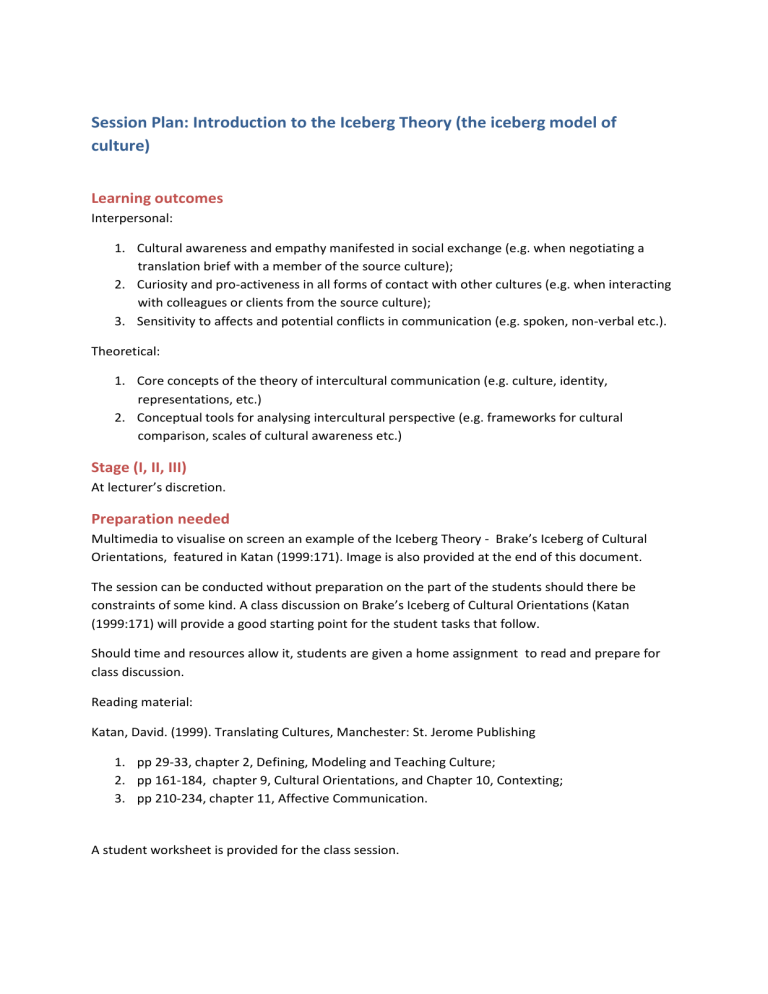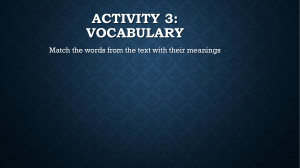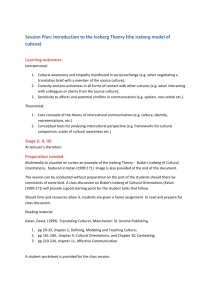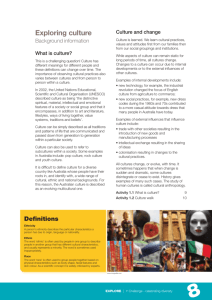
Session Plan: Introduction to the Iceberg Theory (the iceberg model of culture) Learning outcomes Interpersonal: 1. Cultural awareness and empathy manifested in social exchange (e.g. when negotiating a translation brief with a member of the source culture); 2. Curiosity and pro-activeness in all forms of contact with other cultures (e.g. when interacting with colleagues or clients from the source culture); 3. Sensitivity to affects and potential conflicts in communication (e.g. spoken, non-verbal etc.). Theoretical: 1. Core concepts of the theory of intercultural communication (e.g. culture, identity, representations, etc.) 2. Conceptual tools for analysing intercultural perspective (e.g. frameworks for cultural comparison, scales of cultural awareness etc.) Stage (I, II, III) At lecturer’s discretion. Preparation needed Multimedia to visualise on screen an example of the Iceberg Theory - Brake’s Iceberg of Cultural Orientations, featured in Katan (1999:171). Image is also provided at the end of this document. The session can be conducted without preparation on the part of the students should there be constraints of some kind. A class discussion on Brake’s Iceberg of Cultural Orientations (Katan (1999:171) will provide a good starting point for the student tasks that follow. Should time and resources allow it, students are given a home assignment to read and prepare for class discussion. Reading material: Katan, David. (1999). Translating Cultures, Manchester: St. Jerome Publishing 1. pp 29-33, chapter 2, Defining, Modeling and Teaching Culture; 2. pp 161-184, chapter 9, Cultural Orientations, and Chapter 10, Contexting; 3. pp 210-234, chapter 11, Affective Communication. A student worksheet is provided for the class session. Groups Individual, pair work, small groups. Time (total suggested time) 80-90 minutes Background for lecturer (bibliography, anticipated difficulties) The Iceberg Theory suggests that just like an iceberg, culture is made of a visible and an invisible part (Edward T. Hall - 1973, 1976). The visible manifestations of culture are just the tip of the iceberg. However, it is the lower, the hidden part of the iceberg, that is the powerful foundation of these visible manifestations. Brake et al., a team of American management consultants, (1995:34-39) suggest a division of the iceberg as follows: Laws, customs, rituals, gestures, ways of dressing, food and drink and methods of greeting, and saying goodbye… These are all part of culture, but they are just the tip of the cultural iceberg. The most powerful elements of culture are those that lie beneath the surface of everyday interaction. We call these value orientations. Value orientations are preferences for certain outcomes over others. (Katan, 1999:29) Main source: Katan, David. (1999). Translating Cultures, Manchester: St. Jerome Publishing Katan’s book provides a good theoretical foundation for both teacher and student and can alone be used as a background text for this class session. There is a visual representation of Brake et al.’s iceberg ofcultural orientations on page 171 that can be copied or displayed on screen for the discussion part. (Available at the end of this document as well.) Further reading (Iceberg Theory): Hall, Edward T. (1976, 1989). Beyond Culture, NY: Anchor Books Editions. Hall, Edward T. (1973, 1990). The Silent Language, NY: Anchor Books Editions. Hall, Edward T. (1969, 1990). The Hidden Dimension, NY: Anchor Books Editions. http://www.edwardthall.com Should students need explanation about national culture and personal culture, the following citation from http://www.geerthofstede.nl/culture might be of help. “National level Today's world population is divided into some 200 nations. Comparing nations has become part of most social sciences. Some nations are more culturally homogeneous than others; especially large nations like Brazil, China, India and Indonesia comprise culturally different regions. Other culturally similar areas belong politically to different nations: this is in particular the case in Africa. With these limitations, comparing national cultures is still a meaningful and revealing venture. Research by Geert and others has shown that national cultures differ in particular at the level of, usually unconscious, values held by a majority of the population. Values, in this case, are "broad preferences for one state of affairs over others". This differs from the often used meaning "cherished moral convictions", as in "company values". The Hofstede dimensions of national cultures are rooted in our unconscious values. Because values are acquired in childhood, national cultures are remarkably stable over time; national values change is a matter of generations. What we see changing around us, in response to changing circumstances are practices: symbols, heroes and rituals, leaving the underlying values untouched. This is why differences between countries often have such a remarkable historical continuity.” Activities These activities draw students’ attention to: - “the hidden dimension” of culture; - enhance students’ sensitivity to implicit messages, use of non-verbal communication, expression of reaction, personal space , time; - possible conflict points in intercultural contacts and encourage students to anticipate and resolve such conflicts; - promote understanding and tolerance. Lead-in and main: 45-50 minutes The visual representation of the Iceberg Theory model of culture on screen serves as a starting point for the class discussion. The session starts with a brief brainstorming on the elements of culture. Students are asked to think about the implicit and the explicit manifestations of culture and comment on the concepts featured below the waterline in the Iceberg Theory model (the theoretical background is provided by the home reading). Teacher provides feedback. Students are asked to relate these concepts to their national culture and think what picture of it, though highly generalized, they can build. Using these same concepts, students think of their personal culture and compare it to their national culture. They are asked whether these two cultures might conflict at times and how they go about resolving such conflict points. Students are then asked to look at the concepts again and think about how these concepts relate to the culture of the foreign language they translate from/into (providing examples from first-hand experience or from literature). Students’ attention is then directed to the process of negotiating a translation with a prosepective client. Students are asked to focus on the concepts below the waterline and think about which of these concepts they would expect to come into play during the negotiation process. Follow-up: 35-40 minutes Students are given these individual or pair/group work tasks: Task 1 You are negotiating a translation with a member of the source culture. Think of your expectations, attitudes, possibly stereotypes, upon engaging in this business act. Might they affect the process and its outcome? If yes, in what ways? Put down your thoughts. Task 2 You are negotiating a translation with a member of the target culture. Think of your expectations, attitudes, possibly stereotypes, upon engaging in this business act. Might they affect the process and its outcome? If yes, in what ways? Put down your thoughts. Task 3 Pair (or form a small group) with a co-student and discuss your thoughts on Sub-tasks 1 and 2. Do you share common attitudes and expectations? Have you identified possible conflict points in your negotiation activity? E.g. working practices, modes of communication, words and their meaning, body language, eye contact, silences, etc. How might you tackle those? A round up activity. Students share their conclusions in a class discussion. Student worksheet The Iceberg Theory The Iceberg Theory suggests that just like an iceberg, culture is made of a visible and an invisible part (Edward T. Hall - 1973, 1976). The visible manifestations of culture are just the tip of the iceberg. However, it is the lower, the hidden part of the iceberg, that is the powerful foundation of these visible manifestations. Brake et al., a team of American management consultants, (1995:34-39) suggest a division of the iceberg as follows: Laws, customs, rituals, gestures, ways of dressing, food and drink and methods of greeting, and saying goodbye… These are all part of culture, but they are just the tip of the cultural iceberg. The most powerful elements of culture are those that lie beneath the surface of everyday interaction. We call these value orientations. Value orientations are preferences for certain outcomes over others. (Katan, 1999:29) You will find an image of Brake’s version of the Iceberg Model below. Class discussion A. What elements of culture can you think of? B. Look at the concepts in Brake’s version of the Iceberg Model. Which are the explicit and the implicit manifestations of culture? Can you relate these concepts to your national culture? What picture of it, though highly generalized, can you build? Think of your personal culture and compare it to your national culture. Might these two cultures conflict at times? How would you go about resolving such conflict points? Look at the concepts again and think about how these concepts relate to the culture of the foreign language you translate from/into (provide examples from first-hand experience or from literature). Which of the concepts below the waterline would you expect to come into play during the negotiation process with a prospective client? Individual work Task 1 You are negotiating a translation with a member of the source culture. Think of your expectations, attitudes, possibly stereotypes, upon engaging in this business act. Might they affect the process and its outcome? If yes, in what ways? Put down your thoughts. Task 2 You are negotiating a translation with a member of the target culture. Think of your expectations, attitudes, possibly stereotypes, upon engaging in this business act. Might they affect the process and its outcome? If yes, in what ways? Put down your thoughts. Pair/Group work Task 3 Pair (or form a small group) with a co-student and discuss your thoughts on Sub-task 1 and Sub-task 2. Do you share common attitudes and expectations? Have you identified possible conflict points in your negotiation activity? E.g. working practices, modes of communication, words and their meaning, body language, eye contact, silences, etc. How might you tackle those?





